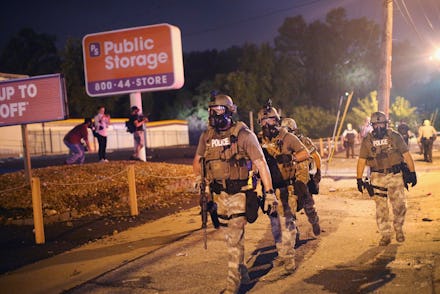5 Disturbing Facts About Police Militarization in America

The news: Those cops in riot armor beating and tear-gassing protesters in Ferguson didn't drop out of thin air. As American police continue to receive billions in military-grade equipment free or subsidized by the Pentagon and Homeland Security, they've predictably started to act more like a military force in hostile territory than the public's protectors.
Here are five facts from the ACLU's June report on the militarization of policing in the United States, which demonstrate just how huge the problem has become and how much work will be needed to reverse it. While all eyes on Ferguson, these facts make clear that riot cops with assault rifles and armored vehicles could just as quickly descend on your neighborhood:
1. Authorities are now deploying SWAT teams for routine police work
A majority of Americans believe marijuana should be legalized and two-thirds think that the government should respond to cocaine and heroin use by providing treatment before prosecuting users. But at the same time that, the ACLU documents that the number of SWAT deployments are out of control. Sixty-two percent of SWAT raids are for drug searches and 65% of those raids involved a battering ram or other breaching device.
What's more, 79% of SWAT-style raids were carried out on a search warrant. When those teams are called out to bring extreme force on suspected criminals, tragedies like the flashbang that severely burned a two-year-old boy or the raid on the wrong house in Miami that injured two children are inevitable.
2. Over 500 police agencies now have a mine-resistant personnel carrier
The ACLU estimates that 500 local authorities now own a mine-resistant ambush protected vehicle (MRAP), heavy armored personnel carriers designed to withstand a roadside bomb blast in Iraq or Afghanistan. In 2007, 27,000 were built to deploy to Iraq at a cost of $50 billion and now that the wars are over, the crafts are being handed out courtesy of the Pentagon's 1033 program. They're potentially heavy enough to crush bridges, though it's hard to imagine a situation where small-town cops would need to deploy what's essentially a tank. In Ferguson, police deployed a smaller vehicle known as a BearCat, which was scary enough:
In 2013, the Washington Post documented a number of small-town police departments with MRAPs, from tiny Madison, Ind., (population 12,000) to Warren County, N.Y. (65,500).
The ACLU says the full haul includes military "bomb suits, night-vision goggles, drones, shock-cuffs, rifles, cell phone sniffers, facial recognition technology, forced-entry tools, biometric devices, utility trucks, APCs, helicopters, GPS devices and personal protective armor."
3. There's no oversight
The ACLU filed public records requests with 255 different law enforcement agencies with 114 denying those requests outright. Those that were produced were "at best sporadic and at worst virtually nonexistent" on the use of SWAT teams or other heavy-handed tactics. According to the ACLU, only one state, Maryland, conducts state-level oversight on SWAT teams, and the records provided to state authorities by the police officers themselves were "for the most part, woefully incomplete, raising serious questions about their utility for internal review of SWAT deployment practices."
On the federal level, the Bureau of Justice Statistics conducts no research on SWAT deployment, use of military-grade hardware or anything related to either. The 1033 program is pretty loose, only requiring an inventory be kept and that the equipment remain unsold. As the Washington Post's Christopher Ingraham reports, obtaining an MRAP only requires program membership and a one-page application:
In 2012, the Pentagon temporarily halted transfers until agencies could provide records of whether 1033 equipment had been lost or sold after a slew of reports indicated many agencies had somehow lost (or planned to sell) military-grade supplies.
4. Access to military-grade equipment makes police more aggressive
Policing expert Jason Fritz suggested to Vox a disturbingly simple reason police were so aggressively cracking down on protesters: "They have the toys, and they just want to play with them, to put it bluntly."
The ACLU's data backs that up, showing that police predictably act with more swagger and force when using heavier equipment, especially on drug raids. SWAT teams were 14 times as likely as regular officers to use flashbangs on drug raids and forcibly entered in more than 60% of drug searches. Dr. Peter Kraska, a professor of justice studies at Eastern Kentucky University, estimates that the number of SWAT raids has grown from around 3,000 annually in the 1980s to around 50,000 this year.
Many times, the police acted without ascertaining whether children would be present, putting them in unnecessary danger. What's more, the ACLU found that armored vehicles were routinely used for raids during which they proved useless.
5. It mostly impacts minorities
As we're now seeing firsthand in Ferguson, Mo., when the cops get rolling with their high-powered new gear, they mostly point it at black and brown people. The ACLU estimated that 61% of SWAT-style raids involved black or Latino suspects. Of those, an astonishing 68% were for drug searches, as opposed to only 38% of raids on white suspects. In every single agency, black people were disproportionately more likely to incur the wrath of a SWAT team than whites — despite well-documented evidence that white folks use drugs at more or less the same rates as black people.